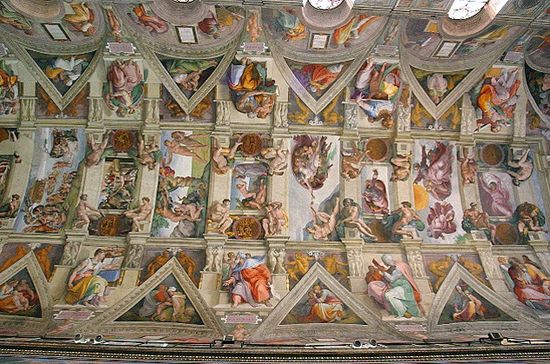 |
| The ceiling of the Sistine Chapel |
Then there was my father, laying on his back on the scaffolding with a cigarette jutting out his mouth, putting swirls on people's ceilings. I remembered seeing a picture of Michelangelo on his scaffolding when I was a kid and I wondered if my father and Michelangelo were related (I used to think all Italians were related).
If you've ever seen fancy design work on people's ceilings, you'll understand what plasterers and artists have in common; a beautiful mixture of art and construction. I grew up around a lot of Italian tradesmen when I was a kid. Plasterers, bricklayers, painters (one guy's name was actually Michelangelo), carpenters, and you can really see the art of Italy in their work.
Now, before you start wondering if I've given up on a cure for spinal cord injury and decided to comment on art or Canadian ethno-cultural history, let me tell you about two more Italians and their scaffolding.
Their names are Angelo Vescovi and Fabrizio Gelain. They aren't artists per se, they are researchers at the CNTE at Niguarda Ca'Granda Hospital, University of Milan-Bicocca and IRCCS Casa Sollievo Della Sofferenze, but we've all heard of the "art of healing".
Like always, I'll give you the link to the deep science of it all, but I would like to look at a few comments made by these researchers.
Gelain states, "we managed, for the first time, to obtain a consistent regeneration of the nervous tissue in chronicized injuries at the spinal cord by using a nanostructured composite scaffold with no cells in it." By this 'no cells' he is talking about things like stem cells or other blood derived cells that are also being worked on to regenerate the damaged spinal cord.
He then goes on to explain that, "By themselves, nanostructured scaffolds probably will not solve the problem of regenerating chronic and acute spinal cord injury" says Gelain. "However, they will become a necessary component of an effective multi-disciplinary therapy in the near future."
This 'multi-disciplinary therapy' comment is what most interests me. My concern is that, even though I really respect scientists and their work, no one seems to be coordinating this 'multi-disciplinary' effort. This is we have to get real people involved in a cure for spinal cord injury. Left only to scientists, they may miss things, or be so enthralled in their own work, that they forget that 'multi-disciplinary' efforts are best.
More government coordination of different approaches is what I feel is missing from the whole effort to cure spinal cord injury, and when I say government, you know that I mean your involvement, because you are the only ones that can make governments act.
If President Roosevelt could plan an atomic bomb in five years, and President Kennedy could lay down a challenge to put a man on the moon in ten years, then what we need now is a leader to demand that all these therapies are brought together to cure spinal cord injury now.
I would hate to see Vescovi and Gelain's very hopeful scaffolding technique lost to the world of Italian art.
No comments:
Post a Comment